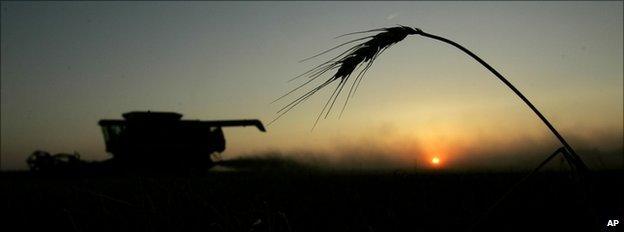Farming: Thoughts on an intense debate
- Published
- comments

In a book that's already annoyed a lot of greens with its enthusiasm for nuclear power and geo-engineering, Mark Lynas's The God Species, external also floats the question of which kind of agriculture is actually best for nature.
The book formed part of my holiday reading - but having accidentally dropped it in the bath, my copy has disintegrated, so I can't bring you any direct quotes from the chapter in question.
But essentially the question is this: is it better for people and for nature to pursue nature-friendly farming over extended areas, or to concentrate agriculture in smaller areas and set aside the rest for nature to do its thing unfettered by plough and seed?
For the author, the second emerges as the favoured option - including the use of genetic technologies where indicated.
GM technologies are just the tip of an iceberg of farming intensification that also includes fertilisers, pesticides, fungicides, mechanisation, high-yield hybrids, irrigation... and much, much more.
Because yields are relatively low in "nature-friendly" farming systems that eschew such technical innovations, he argues, you require more farmland overall - hence, there's more impact on nature overall.
Yet that's a tough sell for much of the green movement, where campaigners in the developed and developing worlds alike argue for more "natural" systems.
As is often the case in this sort of debate, there's a burning need for data.
And this week, the journal Science publishes a paper, external that probably goes further than any other in analysing the "land-sharing v land-sparing" question.
Sparing the land
Researchers from Cambridge University studied the relationship between farming and two measures of biodiversity - bird and tree abundance - in areas of Ghana and India.
Both study areas encompassed farming systems of varying intensity.

Conflicts between nature and farmers can be devastating for wildlife
So in each place, they could look at the amount of food produced and the natural health of the land.
The overall conclusion? Sparing beats sharing.
"Farmland with some retained natural vegetation had more species of birds and trees than high-yielding monocultures of oil palm, rice or wheat but produced far less food energy and profit per hectare," noted lead author Ben Phalan, external.
And the "nature-friendly" farms weren't all they were cracked up to be.
"Compared with forest, they failed to provide good habitat for the majority of bird and tree species in either region."
At least in these areas, then, farming in one place as intensively as you need to and leaving forest as natural as you can in other places beats the low-impact, widespread model.
Growing policy
It's not the end of the story, of course.
The authors admit that conclusions might be different in another country, in another type of ecosystem.

Intensive farming might be best for nature overall - though bringing big changes to the landscape
The write-up on Mongabay, external also raises the time-honoured - but still essentially correct - point that food shortages are not so much a consequence of not producing enough but of sharing it around poorly; though the sheer amount may become a bigger factor, of course, in a future world of nine billion people.
When I phoned Dr Phalan for a chat, he also acknowledged that in a real-world situation where science informs policy-making, you'd have to take into account projections of the future - climate change, water availability (population growth would have an impact) and other things.
"There are lots of ways in which you could make this more complicated and more realistic, and there are lots of other things you could bring in - carbon storage provided by forests, agricultural water use," he said.
"What we're interesting in doing is not providing a final answer, but starting to integrate more than one factor, which hasn't typically been done before."
On the biodiversity side, the type of land separation would also be an issue.
It's well known that if you cut natural habitat up into small chunks, populations of species get fragmented which is not at all good from a conservation point of view.
There's a social equation as well - pertaining more in rich countries than poor, but still of interest - in terms of how we use countryside for recreation.
Ramblers and cyclists might prefer land-sharing as it leads to large tracts of countryside on which you'll see trees and water and maybe even a bird or a a rabbit.
Other people may prefer smaller patches of unfettered wilderness and be prepared to put up with the soulless monoculture in between.
In all honesty, I don't think we're yet at the stage of using this science for policy-making - and neither do the authors of this paper.
Next steps they're planning include similar research in the very different landscapes of Poland, and the development of models that allow more and more factors to be integrated.
But if the broad conclusion turns out to hold true after they and others have gone deeper into it, it will present some challenges to policy-makers - and, indeed, to the green movement.
In a developed country where land has already largely been apportioned, how will governments decide which communities should take on more intensive farms and which live on the edge of a natural wilderness?